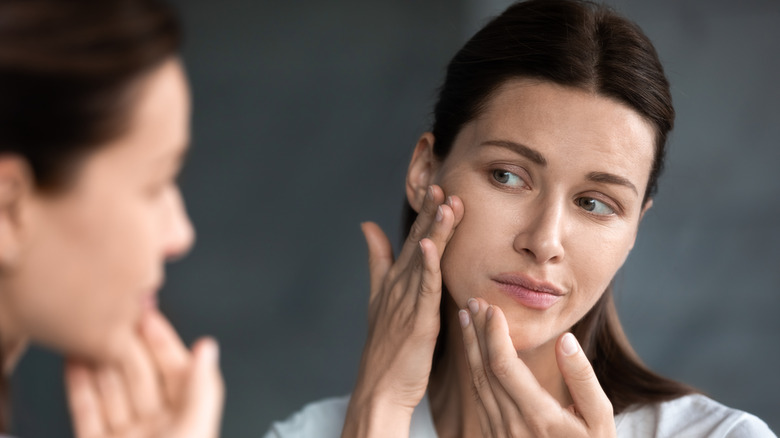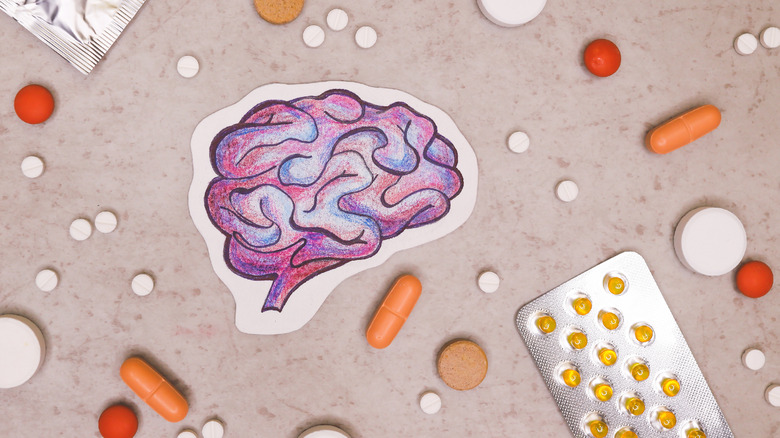Everything You Should Know About Body Dysmorphic Disorder
The following article contains material about a body image disorder, eating disorders, substance abuse, and suicidal ideation.
It is normal to focus on a blemish or a bad haircut for a few days, and it is perfectly natural to have days where you change your shirt a few times because nothing feels quite right. But imagine if this was every day, and if you never stopped thinking about the flaws in your appearance: This is the situation faced by people with body dysmorphic disorder, or BDD (via Mayo Clinic). For people with this disorder, a flaw most of us can ignore for the most part becomes a preoccupation that can affect every aspect of daily life. They might feel so full of shame about these perceived defects that they have trouble leaving the house for work or school, or even to see their loved ones. They might spend disproportionate amounts of time working out, staring in the mirror, or perusing information about plastic surgery and cosmetics. Close relationships can take a hit — a 2010 research review published in Dialogues in Clinical Neuroscience noted that individuals with BDD are more likely to be both divorced and unemployed.
Not only is body dysmorphic disorder a difficult condition to have to deal with, it's increasingly common. According to the Anxiety and Depression Association of America (ADAA), BDD affects 1.7 to 2.4% of the general public, or about one in 50 people. The condition affects men and women fairly evenly.
If you or someone you know is struggling with mental health, please contact the Crisis Text Line by texting HOME to 741741, call the National Alliance on Mental Illness helpline at 1-800-950-NAMI (6264), or visit the National Institute of Mental Health website.
Symptoms of BDD
Individuals with body dysmorphic disorder are most likely to obsess about their skin, hair on their head or body, their face (especially their nose), and their weight (via WebMD). Other potential preoccupations include the penis, musculature, breasts, thighs, buttocks, and even body odor. The Body Dysmorphic Disorder Foundation adds that concerns about the eyes, chin, and teeth might plague individuals. The concerning area may also shift over time – a research review found that "On average, over their lifetime, persons with BDD are preoccupied with five to seven different body parts" (via Dialogues in Clinical Neuroscience). On the other hand, some people don't focus on one particular feature, but instead report feeling "generally ugly" or asymmetrical (per the Body Dysmorphic Disorder Foundation).
Individuals with BDD may try to cover their flaws with clothing, scarves, cosmetics, or hair. Some people with BDD engage in habits like skin picking, which ultimately exacerbates their feelings of stress by causing scarring or other problems. Perhaps you have a friend in school or at work who asks you every day if they "look okay"; this can also be a symptom of BDD — sufferers need a lot of reassurance. These fixations can cause sleeping problems, difficulty concentrating, fatigue, and lead to eating either too much or too little. Many people with BDD develop problems with substance abuse, especially if they feel misunderstood and have difficulty accessing appropriate care.
If you are struggling with an eating disorder and/or suicidal thoughts, or know someone who is, help is available. Visit the National Eating Disorders Association website, contact NEDA's Live Helpline at 1-800-931-2237, and receive 24/7 Crisis Support via text (send NEDA to 741-741); or contact the National Suicide Prevention Lifeline at 1-800-273-TALK (8255).
Other conditions that BDD mimics
The Body Dysmorphic Disorder Foundation calls attention to the commonality of misdiagnosis among those with BDD. Specifically, sufferers have often been misdiagnosed with such conditions as depression, social anxiety, or an eating disorder. Part of the difficulty in diagnosing BDD may stem from the likelihood of comorbidities with other conditions: Research shows that the prevalence of BDD is "8 to 37% in individuals with OCD [obsessive-compulsive disorder], 11 to 13% in social phobia, 26% in trichotillomania [pulling out hair, eyelashes, and eyebrows], and 14 to 42% in atypical major depressive disorder" (via Dialogues in Clinical Neuroscience). Approximately 40% of individuals with anorexia nervosa also have BDD, according to the American Family Physician. And in a study of 208 admitted inpatients at a youth psychiatric facility, those who expressed concerns with body shape or weight were much more likely to also convey symptoms of post-traumatic stress disorder, disassociation, and sexual preoccupation or distress (via Child Psychiatry and Human Development).
Additionally, sometimes patients with BDD may also be misdiagnosed because they don't want to admit how deeply they're preoccupied by their appearance (via Oxford Medicine Online).
BDD is not just low self-esteem
Though the concerns of sufferers might be perceived by others as an issue of self-esteem, the International OCD Foundation notes that BDD goes beyond the normal dissatisfaction each of us has with our appearance, or an aspect of our appearance, every once in a while. Individuals with BDD spend at least one hour a day preoccupied by what they dislike about their body, and this distraction interferes with their ability to live a normal life or causes "significant emotional distress." These individuals also carry out repetitive behaviors, such as excessive grooming, to combat their area of concern. BDD causes upheaval to daily life for the sufferer, with intrusive thoughts affecting their decisions and the way that they live their life (via The BMJ). The mental health implications can be severe: People with BDD often consider suicide because they can't come to terms with their perceived flaws (via the International OCD Foundation).
If you or anyone you know is having suicidal thoughts, please call the National Suicide Prevention Lifeline at 1-800-273-TALK (8255).
Risk factors for BDD
Body dysmorphic disorder appears to have a genetic component, and you are more likely to wrestle with this problem if you have blood relatives who either have BDD themselves or who have been diagnosed with obsessive-compulsive disorder (via Mayo Clinic). Individuals who've gone through traumatic life experiences such as bullying, abuse, or neglect are also more likely to develop BDD, as are those individuals with perfectionistic tendencies, anxiety, or depression. And it's important to note that while perfectionism might sound like a positive trait — what's better than striving for perfection?! — when taken to an extreme it can become a hinderance. Noted researcher on the subject of shame and vulnerability, Brené Brown wrote in her book "The Gifts of Imperfection" that "The need to be or appear to be perfect or even to believe that it's possible to achieve perfection ... Perfectionism is not the same thing as striving to be your best, and it is not about healthy achievement and growth" (via Habits for Wellbeing).
The dangers of BDD
Body dysmorphic disorder can be deadly. Research has shown that an alarming 80% of people with BDD report past or present suicidal ideation, and a quarter of these individuals have attempted suicide (via Dialogues in Clinical Neuroscience). One in three people with BDD also admits to violent behavior against people or property due to their mental health problems. These people describe the violence as a reaction to "anger about looking 'deformed,' inability to fix the 'defect,' delusions of reference (eg, believing that other people are mocking the 'defect'), and feeling rejected by others because of the 'defect.'"
Nearly half of all people with BDD will be diagnosed with a substance use disorder at some point during their life; 43% report an alcohol-use disorder, and 30% report a cannabis-use disorder (via Addiction Center). Additionally, for those obsessed with building muscle, the allure of steroids can be too much to ignore. Many people with muscle dysmorphic disorder (MDD) start with dietary supplements before progressing to either anabolic steroids or growth hormones. Approximately 15-30% of gym-goers use one or the other substance to augment their workouts. For those more focused on thinness than on muscle, cocaine abuse is one method employed to reach otherwise impossible weight loss goals. Since cocaine seriously affects metabolism, quitting can cause sudden extreme weight gain that increases the chances of relapse for those with BDD or eating disorders.
If you or anyone you know is struggling with addiction issues, help is available. Visit the Substance Abuse and Mental Health Services Administration website or contact SAMHSA's National Helpline at 1-800-662-HELP (4357).
Social media and BDD
It's never been easy to be an adolescent or teenager, but "snapchat dysmorphia" is something that many of us never had to deal with. This is when patients seek out surgery to make them look more like their filtered selves, and a 2020 study published in the Journal of Family Medicine and Primary Care indicates it is becoming more common.
Indeed, time spent on social media has been correlated with women feeling of dissatisfied about their bodies (via Body Image). But boys and young men are also contending with BDD at higher rates than ever before (via The Conversation). This has been attributed to social media and the changing representation of men in popular culture. Male models have become more muscular over time, and even male action figures have bulked up in recent years. Some researchers cite our changing social and economic landscape for the increasing rates of male BDD, stating that fewer opportunities for manual and industrial labor have left men without traditional outlets for expressing masculinity. Additionally, one study published in Body Image also found that gay men are especially susceptible to media influence on their body image. They are more likely than straight men to deal with a desire to be thinner, and to have anxiety about the perceived discrepancy between their appearance and the media ideal (via NCBI).
BDD in children and adolescents
Childhood is not always the easy-going, carefree period that we sometimes think of it as being. Symptoms of body dysmorphic disorder typically develop around the age of 12 or 13, and academic achievement and social life falter for most adolescents with the condition (via Mental Health America). Children with BDD often use words like "ugly," "deformed," or "monster" when describing themselves. A big step for recovery among children and adolescents can be understanding that this is a documented medical condition, and that their feelings do not arise from a normal sense of ego or vanity (via Contemporary Pediatrics).
Parents can support a child with BDD by finding them a therapist with expertise in cognitive behavioral therapy, and by learning about the disorder and discussing it with their child (via Nemours KidsHealth). A therapist may also be able to advise parents on how to interact with their child, and which words and actions can best promote their child's recovery process. Taking the time to listen can be very helpful to children struggling with these issues. Treatment for BDD can be a lengthy process — so patience and continued support will be key.
Muscle dysmorphia
Muscle dysmorphia, also commonly referred to as "bigorexia" or "reverse anorexia," often manifests in excessive exercising, calorie counting and obsession with macronutrients, social isolation, a regimented meal schedule, excessive mirror-checking or total avoidance of mirrors, and reliance on anabolic steroids or other performance-enhancing drugs (via the International OCD Foundation). People with muscle dysmorphia are also more likely to develop orthorexia nervosa, an obsession with eating healthy food (via Scientific Reports). In contrast with anorexia nervosa, the focus for those with orthorexia nervosa is on the quality of food rather than the quantity.
The average age at which muscle dysmorphia develops is 19, and it tends to be particularly prevalent among weightlifters, bodybuilders, and military members (via The Conversation). In fact, one 2016 study of U.S. military personnel found that 4.2% of the women and 12.7% of the men suffered from muscle dysmorphia (via Military Medicine). Eating disorders also plague military personnel at an alarming rate — the National Guard Association of the United States reported in 2017 that the diagnosis of eating disorders rose by more than a quarter over the previous five years (via the Toledo Center for Eating Disorders).
If you are struggling with an eating disorder, or know someone who is, help is available. Visit the National Eating Disorders Association website or contact NEDA's Live Helpline at 1-800-931-2237. You can also receive 24/7 Crisis Support via text (send NEDA to 741-741).
Treating BDD through therapy
Cognitive behavioral therapy (CBT) can help teach those with body dysmorphic disorder to handle their misperceptions by turning negative thoughts around before they spiral out of control (via PSYCOM). Mental Health America explains that in CBT, "Individuals first learn how their thinking patterns contribute to their symptoms and then how to change their thoughts so that symptoms are less likely to occur." Mind adds that CBT will help patients improve their thoughts about their body and outside appearance, alter their concerns about the parts of their appearance that they find distressing, and curtail their urges to carry out obsessive behaviors (such as grooming and mirror-checking).
CBT may also incorporate Exposure and Response Prevention (ERP), which encourages people with BDD to confront the kinds of situations that cause their symptoms, such as going to a store without makeup (per PSYCOM). Acceptance and Commitment Therapy trains those with BDD to be present in the moment, and to accept what is happening internally and externally without judging it or trying to change the situation (via the Anxiety and Depression Association of America). This type of therapy also trains the patient to determine what they value in themselves and others, outside of appearance.
Treating BDD with medications
According to Medscape, antidepressants (both selective serotonin uptake inhibitors and tricyclic depressants) may be employed to treat body dysmorphic disorder, although SSRIs are the preferred treatment. Drugs.com clarifies that although Trazadone is technically a serotonin receptor antagonist and reuptake inhibitor (SARI), it is very similar to SSRIs in its mechanism of action — it, too, is frequently used for treating major depressive disorder.
Neuroleptics, lithium, and benzodiazepines are used more rarely (per Medscape). Neuroleptics are antipsychotic medications that target and block the dopamine receptors present in the nervous system, and they are also used in the treatment of schizophrenia, bipolar disorder, and psychosis (via Osmosis). Lithium is a mood stabilizer most commonly used for the treatment of bipolar disorder (via National Alliance on Mental Illness). Benzodiazepines are tranquilizers; you may have heard of Xanax or Valium, which both fall into this class of medications (via WebMD). Occasionally, monoamine oxidase inhibitors (MAOIs) might be used if other treatment options haven't been successful (per Medscape). With any medication, it is important to follow dosage instructions and to consult your doctor or pharmacist with any concerns.
BDD by Proxy
Body Dysmorphic Disorder by Proxy is a condition in which a person becomes obsessed with perceived flaws in someone else's appearance (via the International OCD Foundation). Typically the object of the sufferer's attention is a spouse or significant other, but it can also be a child, parent, sibling, or even someone to whom they're not particularly close. Instead of focusing on their own imperfections, someone with BDD by proxy spends at least an hour per day thinking about the other person's physicality, most often their skin or hair. The person with BDDBP will make "attempts to check, improve, or hide the perceived defect, such as comparing the proxy's appearance to the appearance of others and providing reassurance to the proxy about his or her appearance." The individuals with BDDBP might avoid going out in public with the proxy, and may feel shame about their obsessive thoughts. One small study found that about 4 out of 5 sufferers worried that their significant other would end a relationship if they became aware of the BDDBP, or had previously ended a relationship due to BDDBP symptoms (via Body Image).
Coping with BDD
Other than getting professional help, there are some things that people with body dysmorphic disorder can do to improve their chances of recovery (via Banyan Mental Health). Although their instinct might be to self-isolate, loneliness is a trigger for mental illness. As difficult as it is, people with BDD sometimes have to force themselves to socialize. Meditation can help to improve the stress and anxiety that triggers BDD symptoms. By focusing on the present moment, someone with BDD can gain an understanding of the temporary nature of their thoughts and feelings, which decreases their chances of ruminating or obsessing about something happening right now. They can also begin to realize that they are not defined by their thoughts, and that it's possible to let go of thoughts that aren't serving their wellbeing (via Headspace).
Journaling can help individuals learn to "express their thoughts and emotions without acting on them" (via Banyan Mental Health). Insider further explains that journaling increases self-awareness and can serve as a useful distraction from preoccupation with physical appearance.
Supporting someone with BDD
It can be a difficult and frustrating experience to be involved with someone struggling with BDD. If you're the friend or loved one of someone with BDD, the Body Dysmorphic Disorder Foundation offers plentiful advice to those wanting to support someone with this problem.
It's important to keep in mind that BDD is similar to other mental disorders in that it is out of the sufferers' hands. They aren't trying to be troublesome or annoying to you. Likewise, it's not your fault if a loved one develops this increasingly common disorder. The most important support you can provide is to encourage someone affected by BDD to seek professional treatment. Family members and friends of people with BDD are also advised to "set consistent boundaries with behaviors that are unrelated to BDD, and to problem-solve BDD behavior where it impinges on your family life." For example, don't make excuses or cover for them when the disorder interferes with their daily tasks, or help them to research cosmetic procedures or other image-altering treatments — in essence, don't get roped into the behaviors that arise from the disorder, as this only enables those unhealthy behaviors to continue. As difficult as it seems, it's important to remain patient and positive throughout the recovery process. Be a partner and friend to your loved one and encourage their continued participation in therapy. Celebrate the small victories together, and don't abandon your own self-care.
Looking Ahead with Body Dysmorphic Disorder
The unfortunate truth is that BDD is notoriously difficult to treat (via GoodTherapy). Rather than seeking a cure, people with BDD might want to think of treatment as leading to the "remission" of the disorder. But this process will be long-term, and have ups and downs. According to a recent study published in U.S. Pharmacist, "roughly 20% of patients will adequately recover from BDD, but 40% will subsequently relapse, typically related to an earlier age of onset and severity of BDD symptoms at presentation." Indeed, one prospective study found that the chances of remission are lower among those with more severe BDD, a longer course of BDD, and comorbid personality disorders (via The Journal of Nervous and Mental Disease). Surprisingly, the presence of major depression, a substance use disorder, social phobia, obsessive-compulsive disorder, or an eating disorder did not have a significant impact on the chances of partial or full remission. Still, with an appropriate support system, medical help, and a positive mindset, it is possible for people with BDD to live a normal life and to fight against the obsessive thoughts that haunt them.
If you or someone you know is struggling with mental health, please contact the Crisis Text Line by texting HOME to 741741, call the National Alliance on Mental Illness helpline at 1-800-950-NAMI (6264), or visit the National Institute of Mental Health website.















